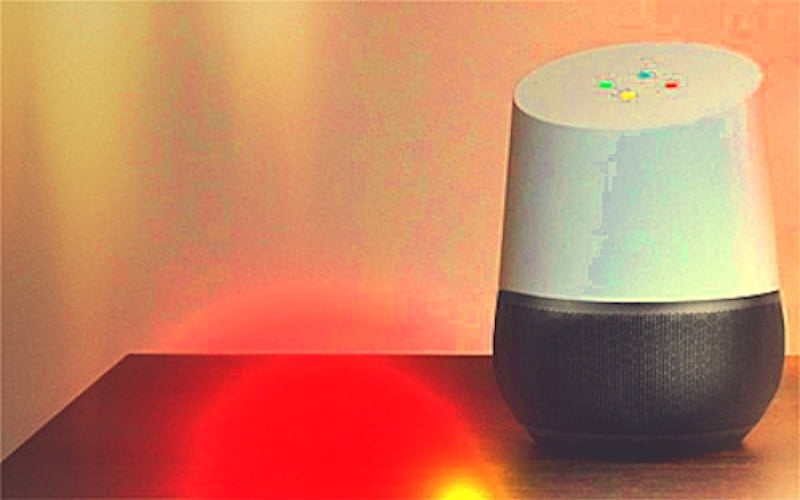With the release of the new Google Home virtual agent recently (after Google’s publication of smart home patents and $US3.2 Billion purchase of Nest Labs and Dropcam), you can’t but wonder about the company’s grand strategy for domestic solutions. Does Google want home automation or home information?
WHY do Google’s plans for home automation systems matter? It’s the company’s seamless underlying penetration of key layers of networked infrastructure and services that are of interest to electronic security people. When you provide so many of the highways down which potential customers drive their network operations and online explorations, it makes perfect sense to increase the depth of services you provide. But is home automation really a way Google can make money, or is there something else behind the play?
The latest device from Google is Google Home, a voice-activated virtual agent that responds to voice commands, answers questions and controls smart home devices including lights and air conditioning. According to reports, Google Home is going to work with a small set of home automation devices — the number and type remains uncertain. Key aspects of the build include AC power and high quality microphones and speaker, the latter to allow Home to play music that can fill a room. The unit is connected to home networks and the Internet via Wi-Fi to a local router.
As we all well know, security and home automation is about inputs and outputs – to drive outputs capable of supporting lights and air conditioning, Google Home must have physical outputs of some sort – hardwired or wireless. Proprietary or Z-Wave? Hard to say. Z-Wave is the logical path but Google is a device manufacturer along with everything else, so other options are possible. Something that’s worth bearing in mind is the way software can merge inputs and outputs into a coherent system at a user interface.

Will security sensors be part of the equation? There’s no reason why not. Repeated studies show that smart home users value security functions above everything else about their automation solutions – Google knows this. It could also be argued that an integral security capability would allow Google to know when residents were in the home. But there’s no reason analytics empowered microphones could not handle this task perfectly well.
According to Mario Queiroz, Google’s VP of product management, Google is competing feature-for-feature in most areas, and in the areas that really matter to the consumer, he says the company is going to do a better job than its competitors. But Queiroz could be talking about any competitor, in particular Amazon Echo, when he makes this point.
Do recent Google patents such as ‘Security Scoring in a Smart-Sensored Home’ tell us anything? A little. Google’s patent included smart entry detectors for windows and doors that send alerts through wireless communications such as ZigBee when windows or doors are open and broken. The same patent detailed a Smart Doorknob and Smart Doorbell capable of recognising a person using information from a mobile phone. Interestingly, Google’s patent also incorporates data sharing between neighbours so that if a burglary takes place across the street, protected houses’ external lights will come on and locks will engage. Considering these developments, it’s possible to get a sense of a number of aspects of Google’s thinking. It’s wireless, interactive, data sharing. That last is a key element here – a normalisation of open-ness of data.

What about Google’s Nest Labs buy? The company paid $3.2 billion for a device manufacturer which turned over $300 million annually. There’s an ocean of blue sky above this deal considering the price-to-earnings ratio. What was the potential Google saw? The name? The engineering expertise? Or was it the ability to jump start its penetration of homes using physical domestic detection devices in a way that did not spook the market? Maybe.
Nest Labs makes the Nest Thermostat and the Nest Protect smoke and carbon monoxide sensor. The thermostat learns the environmental conditions a user likes and adjusts air conditioning or heating systems/furnaces to suit. It also has a latent ZigBee channel onboard, as well as offering an onboard API. Meanwhile, the smoke and carbon monoxide sensor include a warning light, voice address and a hand wave to switch off. This sensor will send a message to a user and report a fire event, as well as instructing a Nest thermostat to turn off the heating.
We observed at the time of this acquisition that the success of Nest suggested users want systems that integrate with the other technologies already enhancing their lives, like to be kept in the loop by their automation and safety solutions, like highly intelligent bits of technology – even if they are only smoke sensors – and are actually prepared to pay a premium for them.
According to analyst Shyam Patil of Wedbush Securities, Google’s long term intention reflected in the purchase of Nest Labs, is to offer products that work on the internet of things – in this case, a connected home managed by intelligent wireless devices that collect data and can be controlled with a smartphone. Conceptually, the Internet of Things is a global network that not only links computers, tablets and phones but connects everything from smoke sensors, to washing machines, to thermostats. It’s more idea than reality at present but there’s certainly potential in such a pervasive network of data collectors. But potential for whom?
Why is Google interested in home automation devices rather than solutions? Does the company have an interest in the security and automation market for its own sake, or are other strategic forces at work? It seems to me it might very well be the latter. Considering the torturous business of selling devices and supporting systems, it’s hard to imagine a software player like Google peddling hardware to a subset of the population leavened by businesses and government organisations. No, Google seems to be looking for something else. A game changer. Something universal that seminally changes the way users interact with data, something ubiquitous – something that serves its business model.
And what is Google’s business model? The company makes 89 per cent of its $US66 billion turnover from advertising revenue across multiple platforms, driven primarily by Google AdWords and Google AdSense. It has link ads with limitless partners and is pervasive on YouTube and practically everywhere else online. How does a virtual agent like Google Home fit into this wildly successful business model? Simple, really. It’s a device that tells Google things about its users, allowing much more highly-targeted (and much more valuable) advertising campaigns.
In 2014 the head of Google’s Android phone software program, Sundar Pichai told the developer’s conference that Google “wanted to know when you’re at home with your kids”. Instructively, Pichai is now Google’s CEO. ♦
By John Adams








